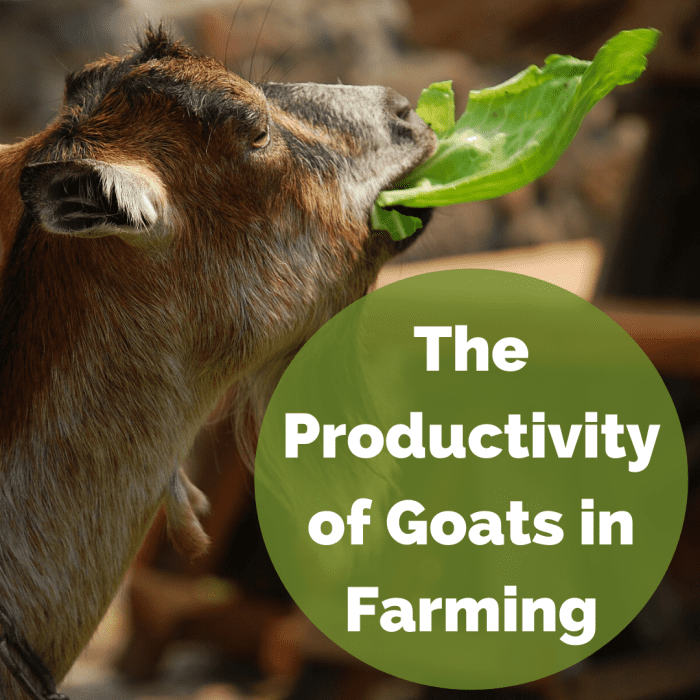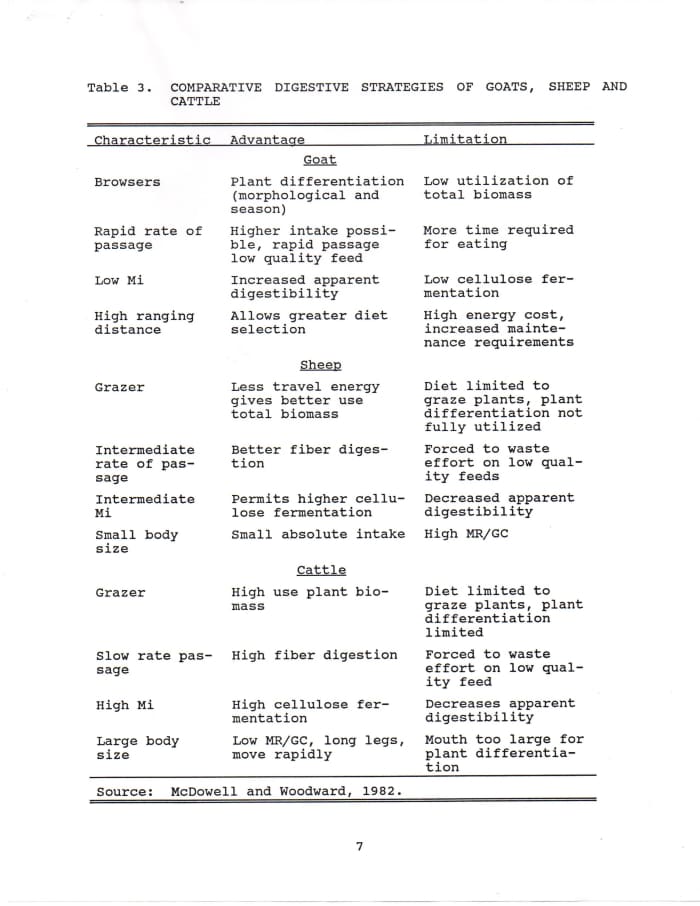Foster Farms Traver Feed Mill Feed Lab
Rider_tiger is a university professor who hopes to leave a legacy of significant, useful information.

Explore the role of goats in farming systems.
Image by pellegrino from Pixabay
There has been a marked rise in the understanding of the characteristics of goats, but unfortunately, these findings have not produced a measurable impact on their meat production. Donor agencies and governments are getting impatient when they determine progress as economic growth.
Within the next decade, environmentalists will be coming down hard on ruminant livestock as major contributors to methane gas in the atmosphere. Production systems with low energy conversion ratios will be targeted for reduction or elimination. Vain efforts are being made in tropical areas to develop systems whereby at least 50 of consumed energy will be allocated by animals to production for buffaloes, cattle and swine.
Feeding Tests With Goats
Of over 100 feeding tests with goats, more than 70% resulted in gains of < 50 g per day, 18% 50-60 g, 9%. 61-120 g and less than 3% with gains > 150 g. Goat producers needs to develop production systems directed to a minimum of 50% of feed energy going to growth or milk yield. Modern concepts of the unique feeding behavior of goats are cited to show that improvement in quality of feeds produced on-farms can be achieved easier and at less cost than for other species.
Since there are few models as yet on production systems with goals of gains of > 100 g per day, experiences from other species are drawn in for possible emulation with goats. Nearly all indicators lead to the conclusion that goats need to become a more productive component of farming systems.

Saanen goats.
Introduction to Goats in Farming
Arguments used to justify greater livestock production in developing countries are based on a need to meet projected deficits in animal products. This is simple and pragmatic, but a more important reason for emphasis on livestock development rests in the contribution they make to total farm production, economic growth and progression of communities. It is the contribution of livestock to economic growth and community welfare that animal supporters have failed to sell.
—Peter J. Brumby
During the last decade, we have seen the most marked rise in history of understanding the characteristics, along with social and economic issues, of goats and sheep in warm climate regions (AboulNaja, 1990; EEP, 1988; Gray et al., 1989: ILCA, 1989, Kang and Reynolds, 1989; SR/CRSP, 1989). Research on these species now provides the phenomenon for inducing change in their contributions.
The majority of the generated technology requires additional outlays of labor and/or capital. Herein lies a dilemma for small ruminant owners and those concerned with development. This is because most goat rearing is classed as extensive systems with the aim of obtaining limited production at the lowest possible cost (Moran-Fehr 1990). Most reports indicate goats generate little in cash income, hence, reluctance by farmers to make investments of capital to improve productivity.
Approaches for Increasing Productivity
Recently, several organizations have explored approaches for increasing productivity. ILCA (1987) initiated a program, Small Ruminant Meat and Milk Thrust. The Small Ruminant CRSP group during their next 5-year plan will focus on:
- Systems to attain the highest capacity to utilize the vegetation for grazing or browsing along with determined supplementation to achieve medium goals in performance.
- Use of supplementary quality forages and/or concentrates to achieve high performance.
To move goat production toward more intensive systems will necessitate numerous changes which are far too involved to cover in a single discussion. Recently, I became quite involved in feeding systems for intensification of cattle and buffaloes performance. I will endeavor to relate some of these experiences to goats.
Scroll to Continue
Dietary Needs
A review of over 100 feeding trials with goats reveals that ADG (average daily gain) is usually low (18 - 25g) on rangelands, unimproved pastures and crop residues. Fertilized pastures will increase ADG (45-50g) but his input may not cover added costs. Limited supplementation with concentrate or browse urea-molasses will raise gain to 50g, but higher quality diets are needed to obtain ADG > 100g.
Upon deliberation, we can recognize that an ADG of < 50 g/d is wasteful of feed energy and unattractive to intensification of labor or expansion of capital investment. Using data on cattle and NRC requirements, estimates were made of the TDN (total digestible nutrients) in the total ration and approximate levels of ADG.
To permit ruminants to express their maximum genetic potential, the weighted average TDN level of all feeds should exceed 70%. Dropping TDN to 60% will support intermediate performance, 200g ADG; 55 & TDN will support 100-150 g ; but ADG declines precipitously with 50% or less TDN and feed conversion ratio becomes low.
Ration Examples
- A ration consisting of quality alfalfa hay and concentrates with 80-85& TDN can be combined for ration > 70% in TDN.
- Good quality forage or dried browse and a concentrate mix of 50% byproducts will enable compiling a ration of about 60% TDN.
- For a ration of 55% TDN, the forage (s) must be at least 50% in TDN and the concentrate mix 62% TDN and 18& CP. A concentrate mix with 6264% TDN is widely practical as it can be made up of 30-35% cereal grains and the rest by-products, plus minerals.
It should be noted that adequate TDN and CP can be obtained with higher levels of byproducts in the concentrate mix, but the calcium to phosphorous ratio is such that serious imbalances can arise (McDowell, et al., 1990)
With farm grown forages, plus concentrate feeding, most U.S. diary herds provide rations in excess of 60% TDN and average milk yield of 7,000 kg. This level of feeding is impractical in warm climate, but with reasonable quality forages (> 50% TDN) and a concentrate supplement utilizing some grains and local by-products, rations of 55% TDN are practical and permit reasonable levels of efficiency.
The Central Points
The central points are:
- Intensification in the feeding of goats is highly warranted.
- To arouse farmer interest, we need to focus on feeding levels equivalent to or near 200% of maintenance requirements. Such can be achieved with rations approximately 55% in TDN (McDowell, 1972).
Feeding Characteristics
Irrespective of species, an understanding of their nutritional characteristics can be useful, especially in planning and management of on-farm feed resources. The comparative digestive strategies of goats, sheep and cattle are summarized in Table 3. It is clear that goats have unique feeding behavior which can be useful. Some examples are: Van Soest (1987) points to an advantage of goats in warm climate regions as being able to exploit nutritively differentiated forages, selectively consuming the better parts which may allow them to perform better than cattle on the same forages.
Harrington (1982) stresses that for Australian conditions of mixed browse and grass, cattle complement goats and increase returns from rangelands. Woodward (1984) found that in use of abandoned farmland in New York State, consisting of mixed grass, weeds and browse, that a mix of goats and cattle extended the period of good animal gains by 35d over cattle alone.

McDowell, 1982
This article is accurate and true to the best of the author's knowledge. Content is for informational or entertainment purposes only and does not substitute for personal counsel or professional advice in business, financial, legal, or technical matters.
Jay C OBrien from Houston, TX USA on September 19, 2018:
Use the milk to drink and for butter and cheese, but do no eat the goat. Eat vegetables with a protein supplement such as yeast or algae.
Source: https://toughnickel.com/self-employment/Goats-in-Farming
0 Response to "Foster Farms Traver Feed Mill Feed Lab"
Post a Comment